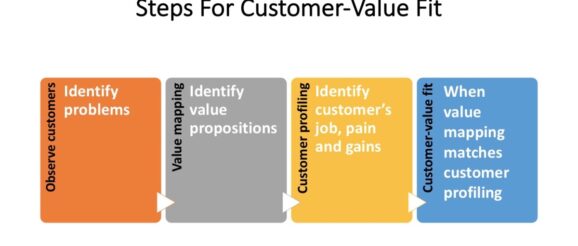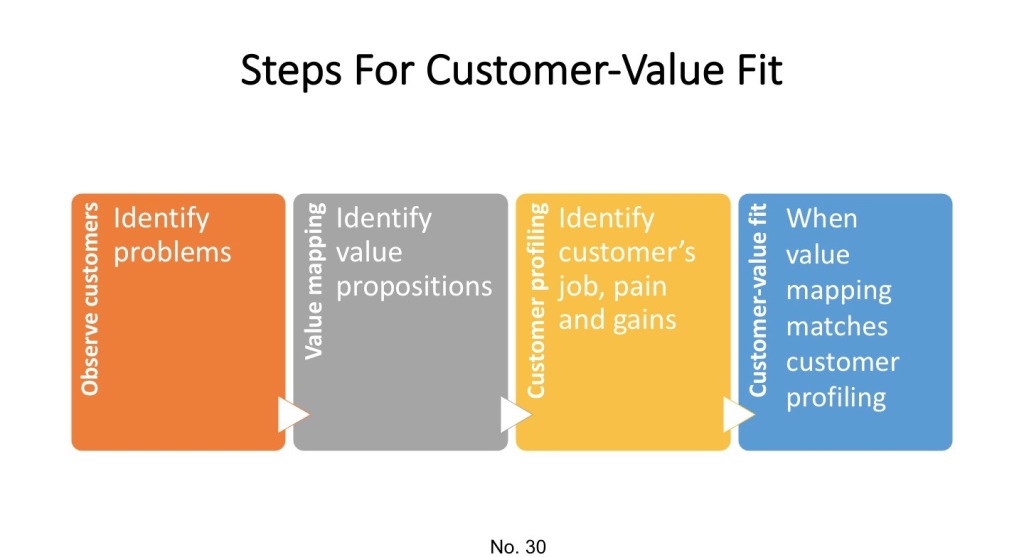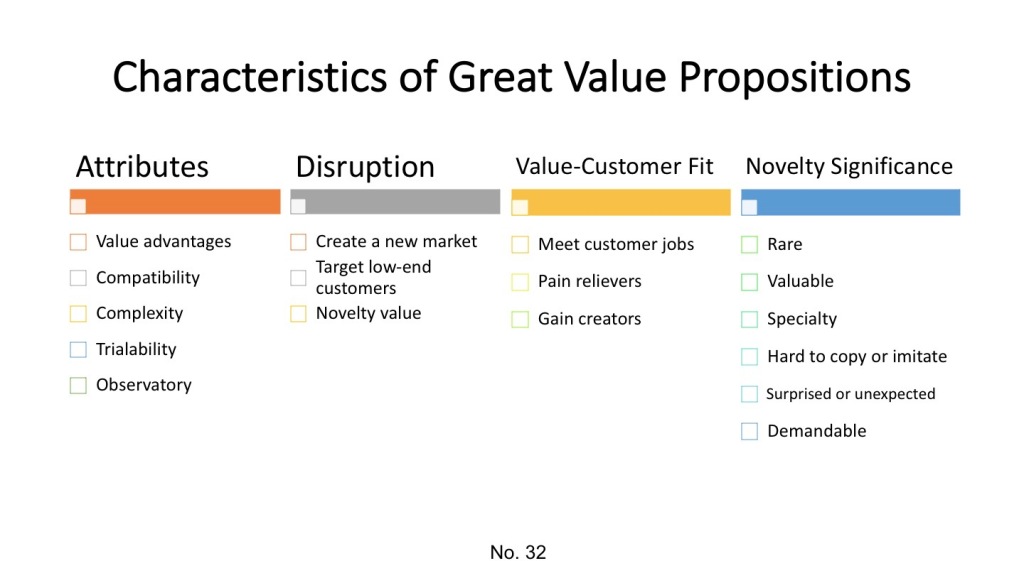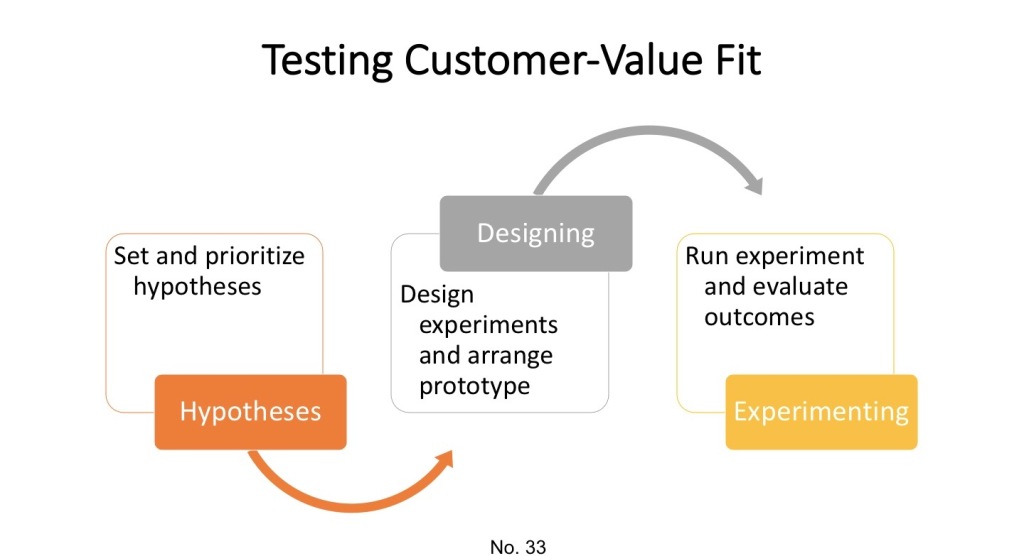What is the customer-value fit for innovation, and what are the steps to achieve it?

Innovations involve creating new values that customers desperately need. Innovators develop values which are the sum of features, functions, or benefits to attract customers and lead markets. Customers can perceive value propositions as worthy if they are original, value advantage, and increase customer experience. In this article, I will highlight the steps for reaching and testing the customer-value fit and the characteristics of successful value propositions.
Steps for customer-value fit
Innovation value, by far, is developed by innovators to meet desired and unexpected needs of customers. In the lean start-up, there are three kinds of values: the first is the problem-solution fit (so-called the concept), the second is the product-market fit (so-called the product, and the third is the growing fit. Customer-value fit is concerned with the first and second value fits. To reach customer-value fit, you observe your customer segment, map values (e.g., products, gain creators, and pain relievers), analyse customer profiles (e.g., jobs to do, pains, and gains), and then match values with the customer profile. Here are the steps to reach the customer-value fit suggested by (Osterwalder, Pigneur, Bernarda, and Smith, 2014)1:

- Step 1- Observe customers: this involves assuming, observing and verifying the customer characteristics in the market. The outcomes of this process include identifying and prioritising problems and understanding the customers’ patterns and stories.
- Step 2- Value mapping: describes the value propositions in your business model and identifies your products or services, pain relievers, and gain creators. For example, the pain-reliever of the digital mobile is about making free video calls and gain-creator for flexible and multi-purpose uses (like calls, cameras, and office work).
- Step 3- Customer profile: involves identifying customers’ jobs, pains, and gains. Customers’ jobs describe what customers do in their work and private lives as functional, social, or emotional jobs. Pains describe the bad outcomes, risks, and obstacles related to customer jobs. Gains reveal the outcomes customers want to achieve or the benefits they are seeking. Gains can be required benefits (e.g., mobile camera), expected (e.g., mobile connection to the internet), desired (mobile design or size or longer battery duration) or unexpected (e.g., digital mobile replacing landline at the time of first launching). There are ways to innovate from a customer profile, addressing more jobs, identifying social and emotional jobs besides the professional ones, helping a lot more customers get a job done, and getting a job done radically or incrementally better.
- Step 4- Customer-value fit: this is when the value mapping meets the customer profile; or when your new products provide pain relievers and gain creators matching the jobs, pains, and gains of your customer.
Characteristics of significant value propositions
The value proposition to be worthy should have some key attributes like being speciality, rare, precious, speciality, hard to imitate and copy, surprise, and customers will have compelling reasons to use it. Here are some characteristics of powerful value propositions:

- Five attributes: are value advantage (most valuable), compatible (easily connected with other systems), usability (simple and easy to use), complexity (multi-functions in one system), trialability (could try before deciding), and observatory (easy to get audiences’ attraction).
- Not existence: create a new market, customers, low price, and meet unmet needs.
- Solution: A solution for unsatisfied jobs, unresolved pains, and unrealised gains that matter most to customers.
- Rare: no similar values, valuable (beneficiary), speciality (unique), hard to copy and imitate, surprise (unexpected), demandable (having high demand).
- Business models: Are embedded in dominant business models that identify how to create, deliver, and capture values.
- Jobs: Go beyond professional jobs and address emotional and social ones.
- Success: Align with how customers measure success.
Testing customer-value fit
Testing in lean methods means conceptualising your idea, continual validated learning, asking customers to try it, and judging your assumptions in line with customers’ feedback. This process is ruled by the validated learning principles, which comprise three iterative steps: build, measure and learn. Testing enables innovators to deliver three values: problem-solution fit (concept creation), and product-market fit (testing your selling plan in the market). Here are the steps to test the customer-value fit:

- Testing principles: be aware of some testing principles that testing is about collecting customers’ opinions on value-customer fit, designing the experiment, learning faster and reducing risk by embracing failure, testing earlier, balancing learnings and vision, and making the test measurable.
- Identify your hypotheses: What needs to be true for your idea or business to work? Use the business model canvases to identify what to test on customer-value fit before you “get out of the building.” Define the most critical factors for your idea to work.
- Prioritise your hypotheses: What could kill your business? Not all assumptions are equally important. Some can kill your business, whereas others matter only once you get the most important hypotheses right. Start with prioritising what’s critical to survival.
- Experiment: Design your experiments with the test criteria showing what factors (or hypothesis) to test, how to test (or experiment design), and acceptance or rejection criteria (metrics of acceptance or rejection of hypotheses).
- Testing: Run experiments, collect information from potential customers, and apply test criteria.
- Validation: Based on the outcomes of these experimental tests, you will validate or invalidate hypotheses.
- Learning: How quickly are you learning? The only thing standing between you and finding out what customers and partners want is the consistency and speed, which you and your team can learn through the design/build, measure, learn cycle.
- This post is sourced from my new book- Your Guide To Reach Innovation.
Final note: the book- Your Guide To Reach Innovation, is an actionable guide to innovation from beginning to end. Enjoy reading the book, and I look forward to your reviews.
Author: Munther Al Dawood
References:
- Osterwalder, A., Pigneur, Y., Bernarda, G., and Smith, A., 2014. Value proposition design, Wiley, New Jersey.
